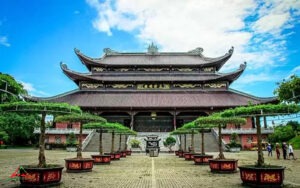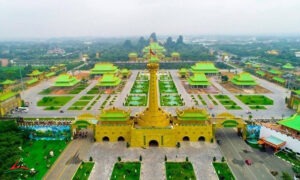The works from the French colonial period, sidewalk shops selling local specialties, motorcycles wriggling on crowded roads… are the first impressions of visitors to Hanoi. For many foreigners, Hanoi has all the interesting things to explore here on its way.
Read more: Hanoi private tour guide: The benefits of the private tours
Hanoi and the most beautiful season
The best time to visit Hanoi is in autumn from August to November and in spring from March to April. Many people think that autumn is the most beautiful weather of the year in Hanoi, with a clear blue sky, the wind may be cold, yellow leaves falling, and the smell of milk flowers sometimes… In the spring, the weather is warm, the streets are like changing into new clothes when the trees bud, the flowers bloom…
Means of Transportation
Hanoi is like the heart of Vietnam, so visitors can conveniently travel to the capital by plane, train, bus, private car, or motorbike from other provinces.
You can take a car, motorbike or bicycle to get around the city. But the experience will be more poetic if you sit on a cyclo watching 36 streets, go on a tricycle tour, or Vespa. Another suggestion worth considering is the double-decker bus, with ticket prices from 130.000 – 599.000 VND.
Hotels and homestays
Hanoi has many accommodation options for tourists such as guesthouses, homestays, hotels, resorts… suitable for pocket money and interests. If you walk in the old town, you can rent a “backpackers” bed with dorm rooms for about 100.000 VND a night, to a high-end hotel for 3.000.000 – 5.000.000 VND/night.
Some special hotels such as Sofitel Legend Metropole Hanoi with French colonial architecture, just a few steps from the Opera House is Hilton Hanoi Opera, Apricot Hotel right on the shore of Hoan Kiem Lake, the famous hotel with West Lake view is Sheraton Hanoi and InterContinental Hanoi Westlake, Lotte Hotel Hanoi on the high floor of Lotte Center 65 floors…
Places to explore
Imperial Citadel of Thang Long

Thang Long Imperial Citadel is a world cultural heritage located in the heart of Hanoi and has more than 1.300 years of history. This place contains unique relics and relics, a testament to Thang Long – Hanoi’s history and the Vietnamese people’s history through the ages.
Hoan Kiem Lake
Hoan Kiem lake is a natural freshwater lake of Ha Noi city, connecting Hang Ngang, Hang Dao, Cau Go, Luong Van Can, Lo Su streets… with the Western Quarter planned by the French more than a century ago. Bao Khanh, Church, Trang Thi, Hang Bai, Dinh Tien Hoang, Trang Tien… Walking around the lake, in addition to enjoying the fresh nature in the middle of the city, you can visit Ngoc Son temple, the old town…
Long Bien bridge

Not only crossing the banks of the Red River, but Long Bien Bridge is also a mark connecting the present and the old memories of people who love Hanoi. Long Bien Bridge was built in 1898, folk also known as Song Cai Bridge or Bodhi Bridge because the bridge over Bodhi Wharf, Gia Lam, Hanoi. With a length of 1,682 m and a bridge section of 896 m, Long Bien Bridge is divided into 9 frames, each 61 m long. According to the original design, the bridge has a total of 19 steel beams placed on 20 piers higher than 40 m.
Tran Quoc Pagoda
Located on the island east of West Lake, Tran Quoc Pagoda used to be at the top of the most beautiful temples in the world. The pagoda has a history of 1,500 years, being the Buddhist center of Thang Long citadel in the Ly and Tran dynasties. It was declared a National Historic Cultural Landmark in 1962. In 2003, the pagoda inaugurated the Lotus Tower 15 m high, with 11 floors.
The Temple of Literature Hanoi

This is Vietnam’s first university. Today visitors can visit the stone steles, solemn grounds with lotus ponds, and gun ponds. Temple of Literature is a rare peaceful and quiet place in the middle of a vibrant city. Visitors will feel the harmony between neck and needle when coming here through the thousand-year-old walls.
TThe Temple of Literature was constructed in 1070 by King Ly Thanh Tong. King Ly Nhan Tong founded the Quoc Tu Giam in 1076. It also holds many precious artifacts and documents, especially 82 doctoral stelae that have been recognized by UNESCO as “World documentary heritage”.
Ho Chi Minh Mausoleum

For Vietnamese people, this is one of the most important attractions in the country. Visitors come to express their respects to Uncle Ho. Visitors should remain silent, wear appropriate clothing, and do not take photos in prohibited areas.
Attending the flag-raising ceremony in the morning is a special experience at the mausoleum of Uncle Ho. If you miss it, you can safely walk around the city and come back here to participate in the flag-raising ceremony at 9 pm every day. The solemn atmosphere covered Ba Dinh square when the loudspeaker sounded to announce the upcoming flag-lowering ceremony. People lined up neatly, watching the guards solemnly bring down the national flag in the music of the song “You are still with us marching”.
One Pillar Pagoda
The building is one of the oldest temples in Hanoi. The temple was built on a wooden tree more than 1,000 years ago. In the 1950s, the rotting original timber should be replaced with a concrete column. Westerners should come here to walk around this area due to the surrounding housing works that are among Hanoi’s most beautiful and impressive.
Old Quarter

Let your feet guide the way, you will discover the most about the colorful nostalgic streets of the capital. No destination, no road map, just turn right, turn left or go straight. One street is full of toys, and the other is full of shoes, clothes, antiques, or sometimes tombstones or motorcycle parts.
If you come here at the end of the day, the experience is even more interesting. Always be prepared to avoid people and cars on the road. In the same way, 1.000 years of Hanoi’s history flows through the streets like blood flowing through each vein, blowing into the breath of both the past and the present.
Museum
The destination not to be missed when going to any city is museums and historical sites. One of the most visited places is the Museum of Ethnology. The Museum of Ethnology presently holds and displays 15,000 artifacts, 42,000 documentary films, paintings, and thousands of other documents on 54 ethnic groups in Vietnam.
Besides, visitors also come to the Vietnam Women’s Museum, Hanoi Museum, National History Museum or Hoa Lo Prison, Hanoi Flag Tower relic… to learn about the culture and history of the city.
To be continued
Read more: Hanoi travel: places to explore, food to try and more things for you (part 2)
Find out more about Hanoi tours here: Northern Vietnam Tours
The best center Vietnam tour: Tour in Vietnam















